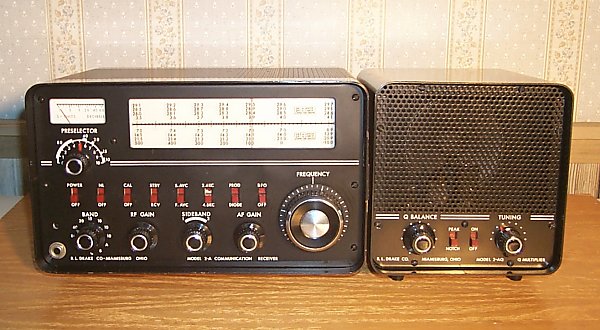|
|
|
Drake 2-A + 2-AQ
|
|
Drake 2-A alone
|
|
|
|
|
Band
| MDS
| Blocking |
Two-tone D.R. |
|
|
| | (20 kHz)
| (20 kHz)
|
|
|
| | | |
|
|
80 meters
| -131 dBm
| 112 dB
| 79 dB |
|
|
40 meters
| -132 dBm
| 111 dB
| 77 dB |
|
|
20 meters
| -132 dBm
| 112 dB
| 79 dB |
|
|
Drake 2-A + 2-AQ Q Multiplier
|
|
|
|
|
Band
| MDS
| Blocking |
Two-tone D.R. |
|
|
| | (20 kHz)
| (20 kHz)
|
|
|
| | | |
|
|
80 meters
| -139 dBm
| 120 dB
| 85 dB |
|
|
40 meters
| -140 dBm
| 118 dB
| 82 dB |
|
|
20 meters
| -139 dBm
| 119 dB
| 84 dB |
|
|
|
|
AM Audio S/N: 33 dB
AM Audio Frequency Response:
|
|
|
|
|
|
|
|
|
|
|
|
|
| |
|
|
100 Hz
| 200 Hz
| 400 Hz
| 600 Hz
| 800 Hz
| 1 kHz
| 2 kHz
| 3 kHz
| 4 kHz
| 5 kHz
| 6 kHz
|
|
| |
|
|
-6 dB
| -1 dB
| 0 dB
| 0 dB
| 0 dB
| 0 dB
| -5 dB
| -12 dB
| -23 dB
| -30 dB
| -33 dB
|
|
|
|
|
|
|
|
|
|
| |
|
|
Mod%
| 100 Hz
| 200 Hz
| 400 Hz
| 600 Hz
| 800 Hz
| 1 kHz
| 2 kHz
|
|
| |
|
|
30%
| 28%
| 10%
| 5.6%
| 4.5%
| 4.0%
| 4.0%
| 5.0%
|
|
50%
| 22%
| 7.9%
| 5.0%
| 4.5%
| 5.0%
| 5.0%
| 4.0%
|
|
70%
| 20%
| 8.9%
| 7.9%
| 7.9%
| 8.9%
| 10%
| 5.6%
|
|
90%
| 22%
| 14%
| 14%
| 14%
| 14%
| 14%
| 10%
|
|
100%
| 25%
| 18%
| 16%
| 16%
| 16%
| 16%
| 13%
|
|
|
|
|
Notes: The Drake 2-A by itself has a minimum bandwidth of 2.4 kHz.
The Q multiplier, while capable of being adjusted down to a bandwidth of about 150 Hz (at -6 dB) when on the hairy edge of oscillation, was backed off for a bandwidth of roughly 400 Hz (at - 6 dB) to be consistent with other receivers tested.
MDS improvement was on the order of 8 dB which agrees with the i-f bandwidth reduction from 2.4 kHz to 400 Hz. Surprisingly , the blocking and two-tone dynamic range numbers were not adversely affected. Blocking dynamic range improved by virtue of being referenced to the lower noise floor...although it didn't improve by a like amount. Two-tone IMD dynamic range also improved by virtue of being referenced to the noise floor. Third order products change at a rate of 3 dB for every 1 dB change of input level so the best improvement one could hope for would be 2/3 X the reduction in MDS.
During testing the bandwidth was narrowed to the point of oscillation while looking for bad behavior. Taking into account the extra receiver gain, there were no dramatic reductions in blocking or two-tone dynamic range even at the edge of oscillation.
The tests certainly show that the Q multiplier reduces the receiver bandwidth without compromising receiver dynamic range...at least with the 2-A and 2-AQ setup.
AM frequency response was fairly restricted due to the 4.8 kHz maximum i-f bandwidth. AM distortion numbers show the somewhat typical increase at lower audio frequencies - most often caused by the low audio frequencies riding on the AGC line. Also there is the usual increase in audio distortion as the modulation percentage increases. This is due to the detector's inability to cleanly demodulate the higher amplitude levels.
|
| | | | |

